Lessons From Kuwait: How the Country’s Rentier Democracy Is Slowing Its Energy Transition

Table of Contents
Author(s)
Share this Publication
- Print This Publication
- Cite This Publication Copy Citation
Osamah Alsayegh, "Lessons From Kuwait: How the Country’s Rentier Democracy Is Slowing Its Energy Transition" (Houston: Rice University’s Baker Institute for Public Policy, April 5, 2023), https://doi.org/10.25613/R1ZE-AM65.
Tags
Introduction
Although achieving a sustainable energy transition poses critical challenges for the hydrocarbon-dependent economies of the Gulf Cooperation Council (GCC), the GCC countries have announced ambitious energy transition targets, seizing potential economic opportunities involving clean technology deployment and energy demand management measures. Energy transition progress varies among the GCC states, however, Kuwait, for example — the only democratic country in the GCC — has made slow headway, giving rise to the question of whether there is a relationship between political system type and advancement toward energy transition goals.
This study investigates the role of the GCC states’ political systems in advancing (or discouraging) the energy transition. It focuses on Kuwait, which embraces a democratic political system and has made slow progress toward energy transition targets, and addresses the following questions:
- Does democracy in Kuwait have a direct impact, indirect impact, or no influence on energy transition development?
- What is the extent of the impact of Kuwait’s political system on its energy transition agenda?
- What aspects (if any) of Kuwait’s political system hinder energy transition development?
To answer these research questions, a review of Kuwait’s legal and legislative proposals and approvals from Jan. 1, 2012, to Jan. 31, 2023, was completed using the document database made available by the Kuwait National Assembly, the country’s legislative body. Then, a quantitative and associated qualitative analysis was carried out to deduce the results. The findings suggest that Kuwait’s broader political system has persistently played an indirect role in slowing the country’s pace of progress toward the energy transition. The study concludes by recommending short- and long-term mitigation policies to stimulate Kuwait’s energy transition development.
Background
The world’s energy system has always been in transition due to economic and political developments.[1] In the past half-century, environmental concerns have emerged as a new primary driver of global energy transitions.[2] Today’s worldwide transition toward sustainable energy features the addition of clean energy sources (e.g., renewable, hydrogen, and nuclear energy) to the existing conventional energy mix; the integration of emission mitigation technologies by the energy sector (e.g., carbon capture, storage, and utilization, known as CCUS); and the adoption of energy efficiency measures to mitigate carbon emissions. The energy transition is capital-intensive, requiring investments in clean energy assets and supporting infrastructure; it is estimated that achieving net-zero carbon emissions would require an investment of approximately $275 trillion by 2050, or $9.2 trillion per year on average. Globally, this is about 1.3 times the size of corporate profits, 66% of tax revenues, and 18.4% of household spending.[3]
As such, a nation’s political system has a strong role in the development and progress of its energy transition process.[4] It influences the design of the transition’s governance framework, the development of its financing tools, and the regulation of its market, in addition to driving public opinion and awareness.[5] Historically, there has been a causal relationship between a society’s transition from one energy system to another with its type of political system. This causal relationship has evolved throughout time.[6]
In nations with democratic political systems, the political strategies surrounding the energy transition usually involve coalitional structures that advocate for (or discourage) the transition process. Such coalitions typically involve government, businesses, and the public.[7] Nations develop energy policies through the framework of their political ideology and the influence of public opinion.[8] As such, the sociopolitical feasibility of achieving a net-zero target is always taken into consideration, in addition to technological and economic feasibility.[9]
Nondemocratic nations (e.g., those with authoritarian, monarchical, or totalitarian political systems) offer the public limited or no input into the decision-making process when adopting policies and administrative rules. Most of the enterprises that lead the energy transition processes in these countries are owned and managed by the state. Hence, decisions about energy transition investment are usually motivated by top-down political imperatives. An example of such an enterprise is Masdar, a renewable energy company owned by the United Arab Emirates (UAE)[10] whose shareholders include other UAE-owned entities, i.e., Abu Dhabi National Oil Company (ADNOC), Mubadala Investment Company, and Abu Dhabi National Energy Company PJSC (TAQA). With some exceptions, such as China, there are opportunities in industrialized nondemocratic nations for subsidiary and marginal enterprises to function independently and compete in global markets.[11] In general, however, high-level strategies regarding the energy transition in nondemocratic countries are initiated and led by the elite. With the exception of Kuwait, the GCC states — where energy transition plans are advocated for by ruling families — are a tangible example.
The GCC states’ overall progress toward net-zero targets shows Kuwait as an outlier in energy transition endeavors — hence, the research motive for investigating the role of the GCC countries’ political systems in the development of their national energy transition efforts.
To the best of the author’s knowledge, there has not so far been any research published on this particular niche topic. The goal of this study is to highlight the challenges facing the development of a sustainable energy system in a democratic rentier nation — i.e., Kuwait. In this study, a “rentier nation” is a state that receives all or a major portion of its income from the use (or “rent”) of its indigenous natural resources by foreign governments or individuals, without an increase in the productivity of its domestic economy. A democratic rentier nation adopts a democratic political system with a constitution that obliges the state to provide social benefits to its citizens including public jobs, housing, free health care, free education, and tax exemptions for citizens. Examples of such arrangements are illustrated in articles 10, 11, and 41 of the Kuwait Constitution, which require the state to take care of youth and protect them from exploitation and “moral, physical and spiritual neglect” and provide social security, social aid, care and health services, and jobs to citizens.[12]
Because it is the only democratic GCC state and lags behind the others with regard to energy transition development, Kuwait is the focus of this study. The lessons that emerge are a call for Kuwait’s policymakers and elite to reform their political system into one capable of responding to the short- and long-term challenges of the sustainable energy transition.
The Political Systems of GCC States: A Background
The case of the GCC states is somewhat unique. Though their people share similar cultures and values, their political systems vary significantly. Most are absolute monarchies with limited political representation and restricted civil liberties. Kuwait is the exception; its public contributes to the country’s administration by influencing legislation and monitoring the government-run employment system via the Kuwaiti National Assembly, whose members are freely elected.
Bahrain, Oman, and the UAE each have a bicameral parliament structure. Members of one legislative chamber are royally appointed and usually referred to as the “Shura,” i.e., the advisory council. The members of the other chamber are elected by the public. There is an equal number of members in each chamber (except in Oman — see Table 1), and the chambers have the same voting weight. Since at least one elected member can generally be expected to side with the Shura, the Shura largely has the upper hand in directing the legislative process. Saudi Arabia and Qatar only have a Shura (Table 1). Most of the ruling families of the GCC hold absolute power, and are often the main decision-makers. Essentially, in a typical GCC state, the ruling family holds both political and economic power, meaning the government is profoundly centralized.
Table 1 — Parliamentary Structures of Gulf Cooperation Council States

Kuwait is a constitutional monarchy headed by the emir. Constitutionally, the emir must be a member of the ruling Al-Sabah family and descended from Mubarak Al-Sabah, who ruled until 1915. The system of government is based on the principle of separated executive, legislative, and judicial powers, which are all headed by the emir. The emir also appoints the prime minister, who holds the authority to appoint the state secretaries who make up the Kuwaiti Cabinet.
Legislative authority belongs to the National Assembly, whose members are democratically elected every four years. With each legislative election, a new government is formed. Since Kuwait formally gained independence from Britain in 1961 and formed its first government in 1962, there have been 42 appointed governments. The average duration of each government is less than 1.5 years; this reflects the high level of friction between the Cabinet and the National Assembly. Such tension has impacted the pace of progress for the country’s developmental projects,[13] including renewable energy deployments. These deployments are unlikely to reach Kuwait’s stated renewable energy target — i.e., generate 15% of electricity demand by 2030 — if both the Cabinet and National Assembly continue their status quo performance.
Motivations and Research Questions
Unlike other democratic nations, Kuwait lacks a process by which coalitions of government, businesses, and the public can influence the political strategy surrounding the energy transition. This is reflected in its energy transition progress. The Arab Future Energy Index (AFEX), which uses 30 indicators to assess key aspects of the energy market in Arab countries, including policies, institutional and technical capacities, strategies, socioeconomic factors, and investments,[14] ranks the GCC states by their level of progress in renewable energy and energy efficiency. Kuwait — the GCC’s only democratic nation — has fallen behind most of the nondemocratic GCC states in these areas (Table 2).
Table 2 — Indicator Scores Assessing Gulf Cooperation Council States’ Progress in Renewable Energy and Energy Efficiency (out of 100)

So far, the UAE has outperformed Kuwait in the deployment of renewable energy systems with regard to the pace of annual installed capacity and overall total capacity (Figure 1). In 2021, the UAE’s total installed renewable energy systems capacity was 2,700 megawatts (MW), while Kuwait’s was 100 MW. Accordingly, the UAE’s renewable energy intensity — the quantity of clean energy consumed in its economy, i.e., renewable energy consumed per unit of GDP — was 17 watt-hours (Wh) per U.S. dollar; Kuwait’s was 2 Wh per U.S. dollar.[15] Concerning energy demand management, the UAE has also advanced competent measures to encourage efficient energy consumption. For example, the residential electricity tariff in Dubai, UAE, ranges from $US 0.063 per kilowatt-hour (kWh) to $US 0.10 per kWh depending on the consumption level (Table 3).[16] In Kuwait, the residential electricity tariff is fixed at $US 0.007 per kWh for Kuwaiti citizens and $US 0.016 per kWh for noncitizens living in apartments.[17] The average residential electricity tariff in Dubai is more than sixfold that in Kuwait.
Table 3 — Residential Sector Electricity Tariffs in Kuwait and Dubai
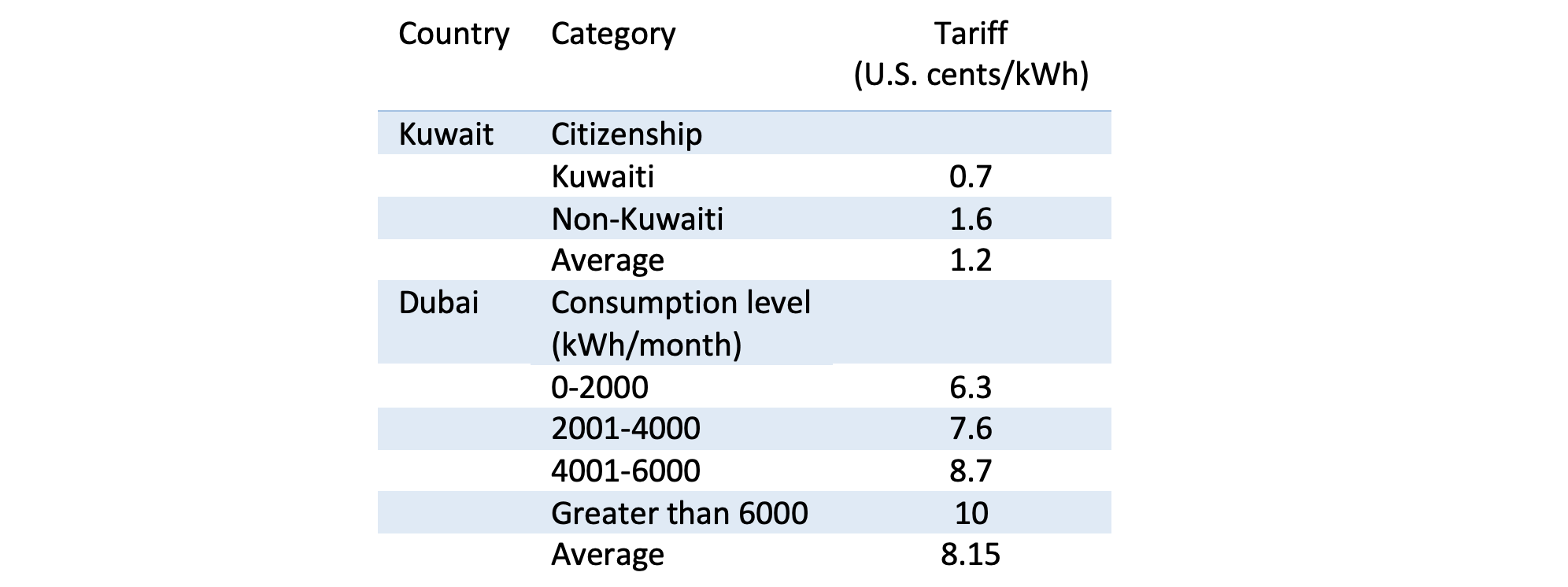
Figure 1 — Renewable Energy Systems Deployment in Kuwait and the UAE
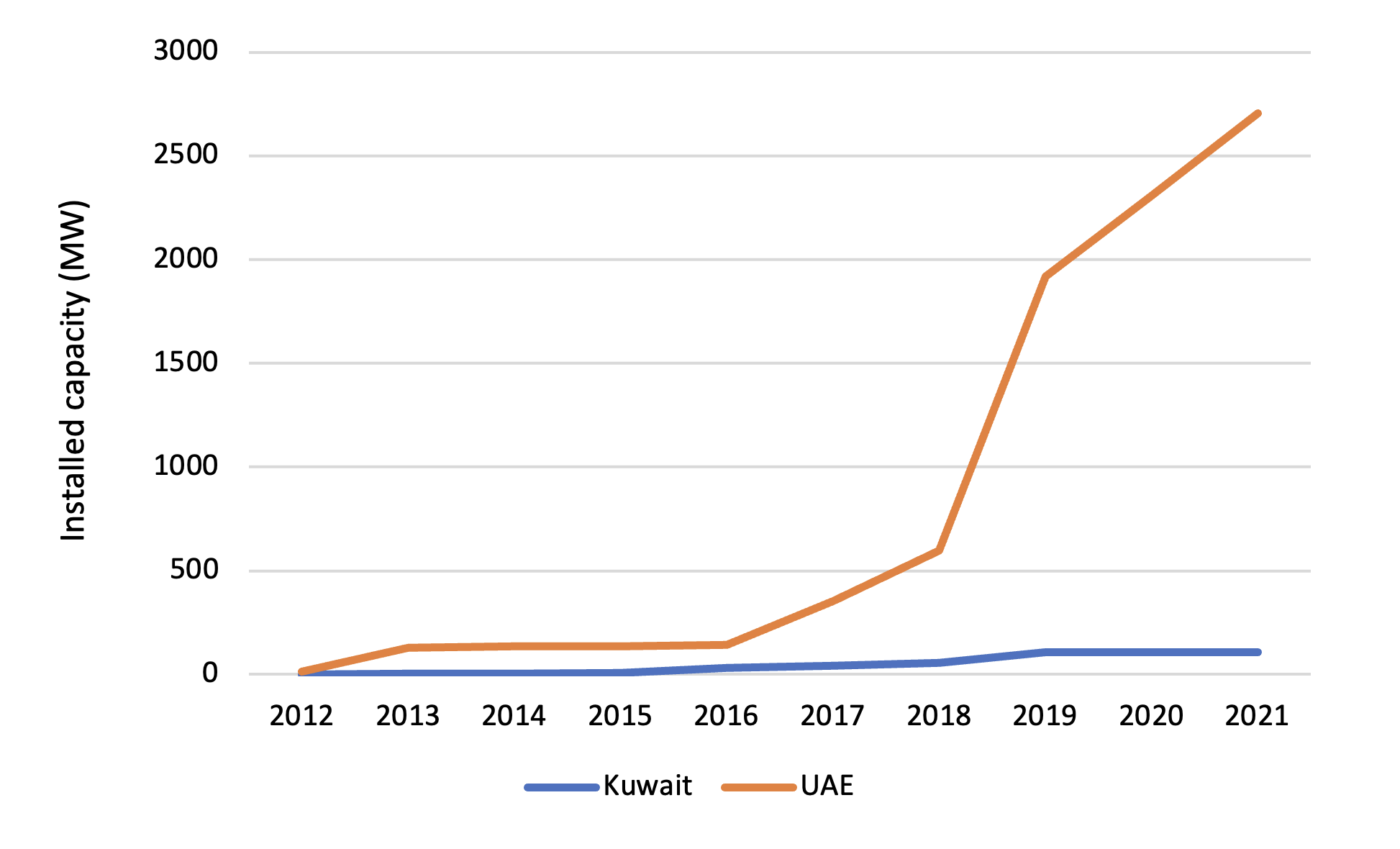
The contrasts illustrated above raise the question of whether Kuwait’s democratic political system plays a role in holding back the nation’s energy transition progress. The research questions addressed in this paper are meant to assess the impact of a democratic political system (i.e., that of Kuwait) on a GCC state’s ability to advance a clean energy agenda: 1) Does democracy in Kuwait have a direct impact, an indirect impact, or no influence on energy transition development? 2) What is the extent of the impact of Kuwait’s political system on its energy transition agenda? 3) What aspects (if any) of Kuwait’s political system hinder energy transition development?
Methodology
An empirical, evidence-based methodology was used to address these research questions. Using the Kuwait National Assembly database, legislative proposals and approvals from Jan. 1, 2012, to Jan. 31, 2023, were identified and reviewed. In 2012, the late Emir Sheikh Sabah Al-Ahmad Al-Sabah announced that Kuwait would meet 15% of its local energy demand from renewable sources by 2030 — hence, the date range used for this study. For the purposes of this study, 2012 is considered the official year that Kuwait began to work toward transitioning its various sectors to a mix of conventional and clean energies.
The applied methodology involved 1) surveying the Kuwait National Assembly database and identifying energy transition-related actions, 2) categorizing each energy transition-related action by procedure type, e.g., bills and enacted laws, 3) assessing and classifying each action according to the corresponding energy transition pillar (e.g., governance, research and development, etc.), 4) analyzing the level of motivation for a particular action and inferring the role of the political system toward the outcome, and 5) addressing the research questions. Figure 2 illustrates the methodological scheme.
Figure 2 — Research Methodology
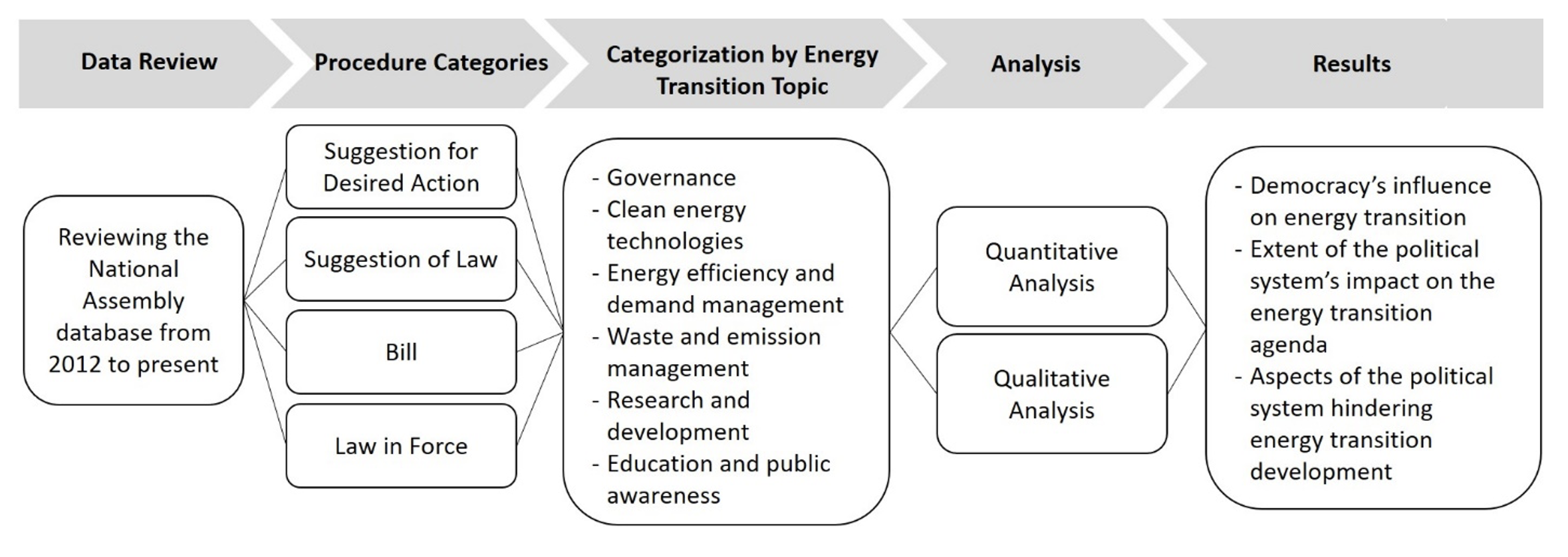
The National Assembly’s online information system[18] was utilized to access the database of legislative actions and other related documents. The database consists of 26 sections, each covering a particular topic, activity, or affair. Examples of sections are “Emiri Decrees,” full-text decrees issued by the emir of Kuwait from 1954 to date; “Parliament Meeting Records,” full-text meeting records of assembly sessions from 1962 to date; “Interrogation,” full-text records of assembly testimonies from 1963 to date; and “Suggestion of Law,” full-text documents that include proposed legal clauses from 1963 to date.
Four sections were reviewed:
- Suggestion for Desired Action: Contains proposals by assembly members for actions within the capacity of either the Cabinet or National Assembly.
- Suggestion of Law: Contains proposed laws with defined objectives and general clauses.
- Bill: Contains full texts of laws proposed by either the Cabinet or National Assembly.
- Law in Force: Includes full texts of laws that have been enacted.
These four sections were selected because they provide information on the level of awareness, interest, and motivation with regard to the energy transition among the public (represented by the National Assembly) and the overall political system (i.e., the National Assembly and Cabinet).
From Jan. 1, 2012, to Jan. 31, 2023, the four sections comprise 11,140 total documents: 5,847 suggestions for desired actions, 3,510 suggestions of law, 881 bills, and 902 laws that have gone into force. The following keywords were used to identify the documents: alternative, carbon, conservation, electricity, emission, energy, environment, fuel, gas, nuclear, oil, petroleum, renewable, subsidy, tariff, tax, waste, and water.
Table 4 displays the search results. The documents are categorized under titles that reflect their general topic. The dates of legislative requests and follow-ups are also included.
Table 4 — Proposed and Enacted Legislation Related to the Energy Transition (Jan. 1, 2012, to Jan. 31, 2023)
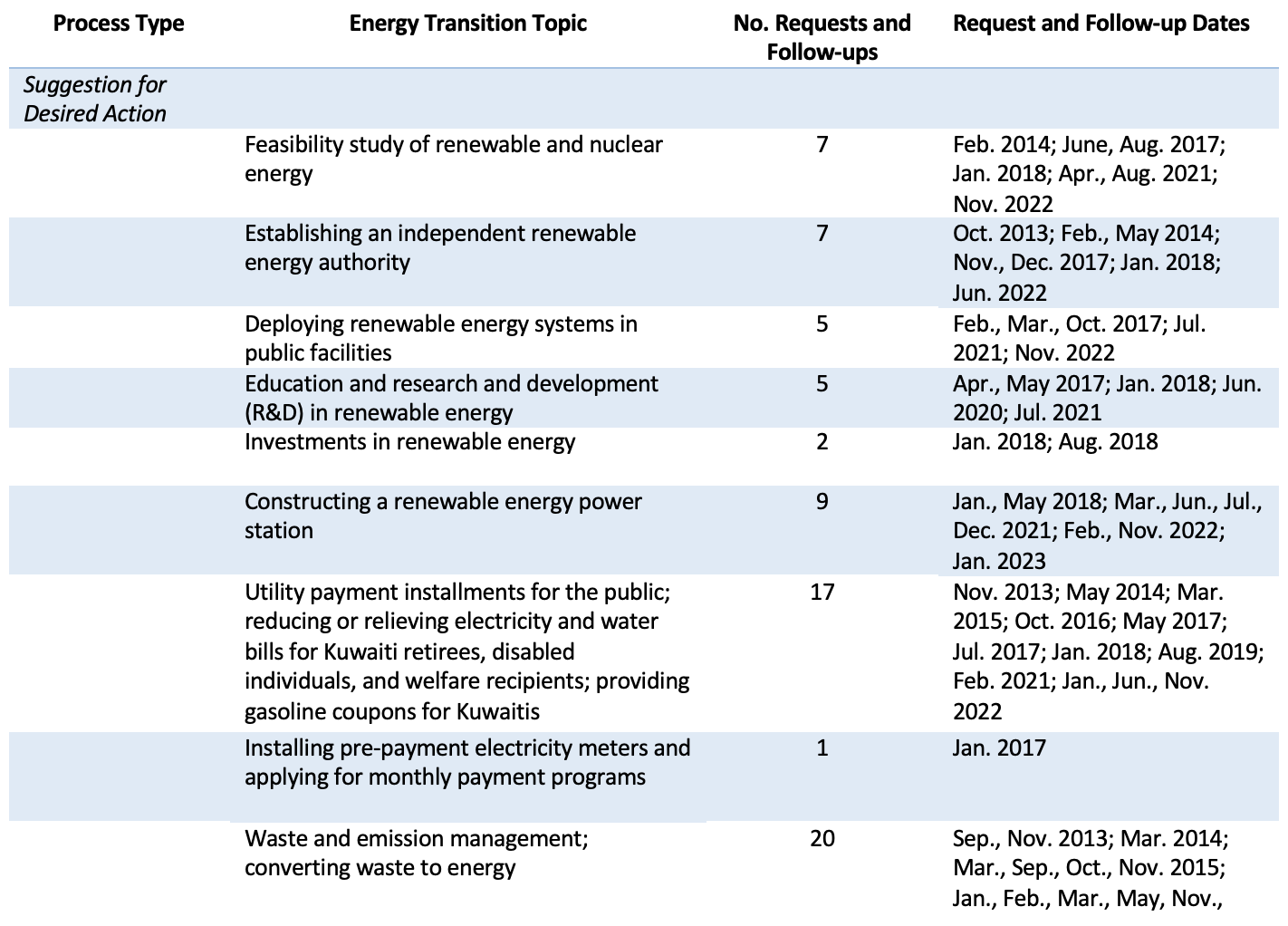
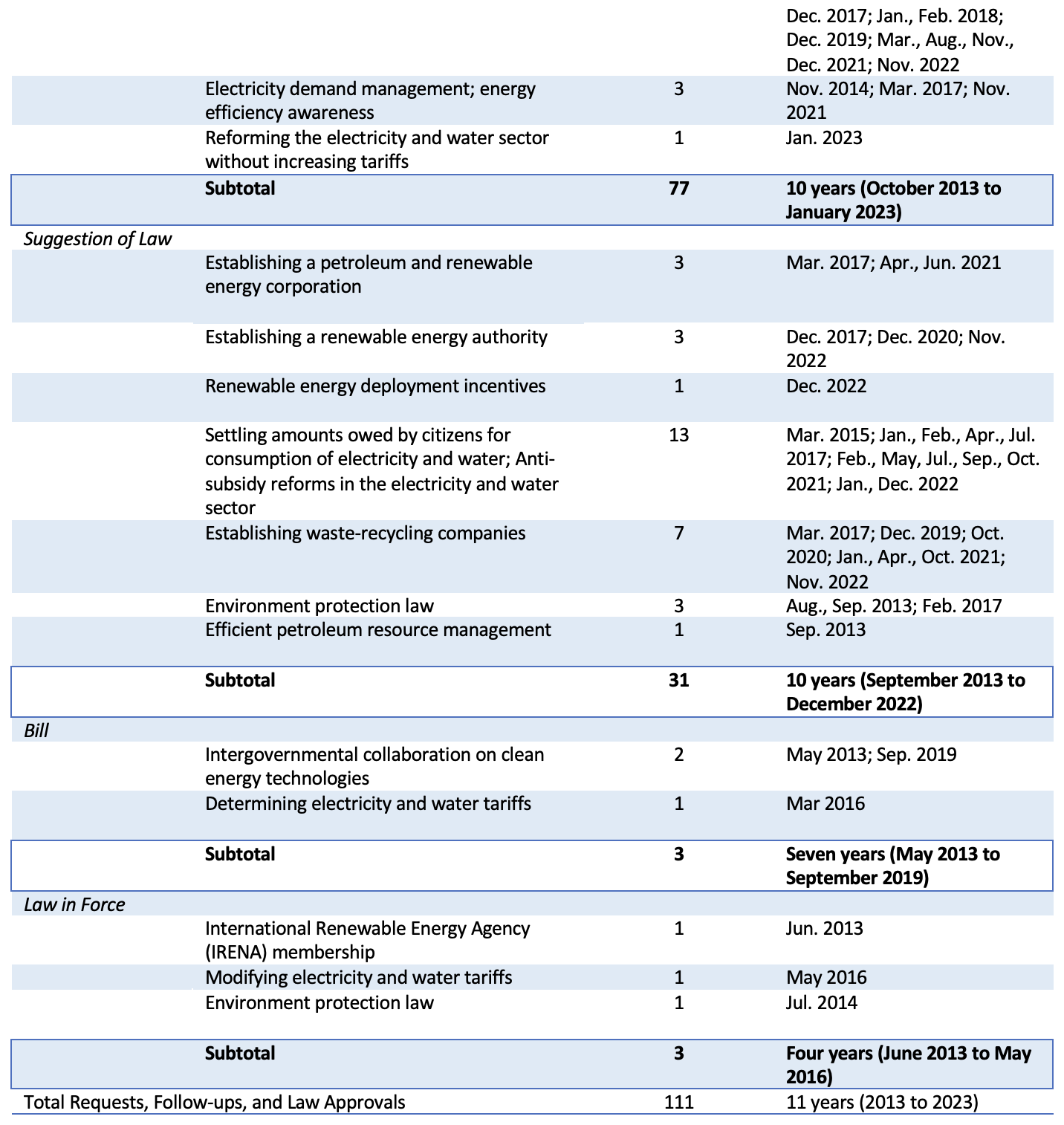
Note Some requests were repeated several times in the same month.
Analysis and Implications
From Jan. 1, 2012, to Jan. 31, 2023, there were approximately 11,140 requests, follow-ups, and approvals regarding proposed legislation. Of these, 111 were related to the energy transition, comprising close to 1% of all appeals (Table 4). The Kuwaiti Cabinet and National Assembly succeeded in passing only three energy transition-related laws — i.e., 0.3% of 902 laws approved in total. This raises the question of how popular energy transition affairs are in the country and where they rank in priority within the political system.
Figure 3 — Suggestions for Renewable Energy & Energy Efficiency Actions and Laws (National Assembly and Cabinet)
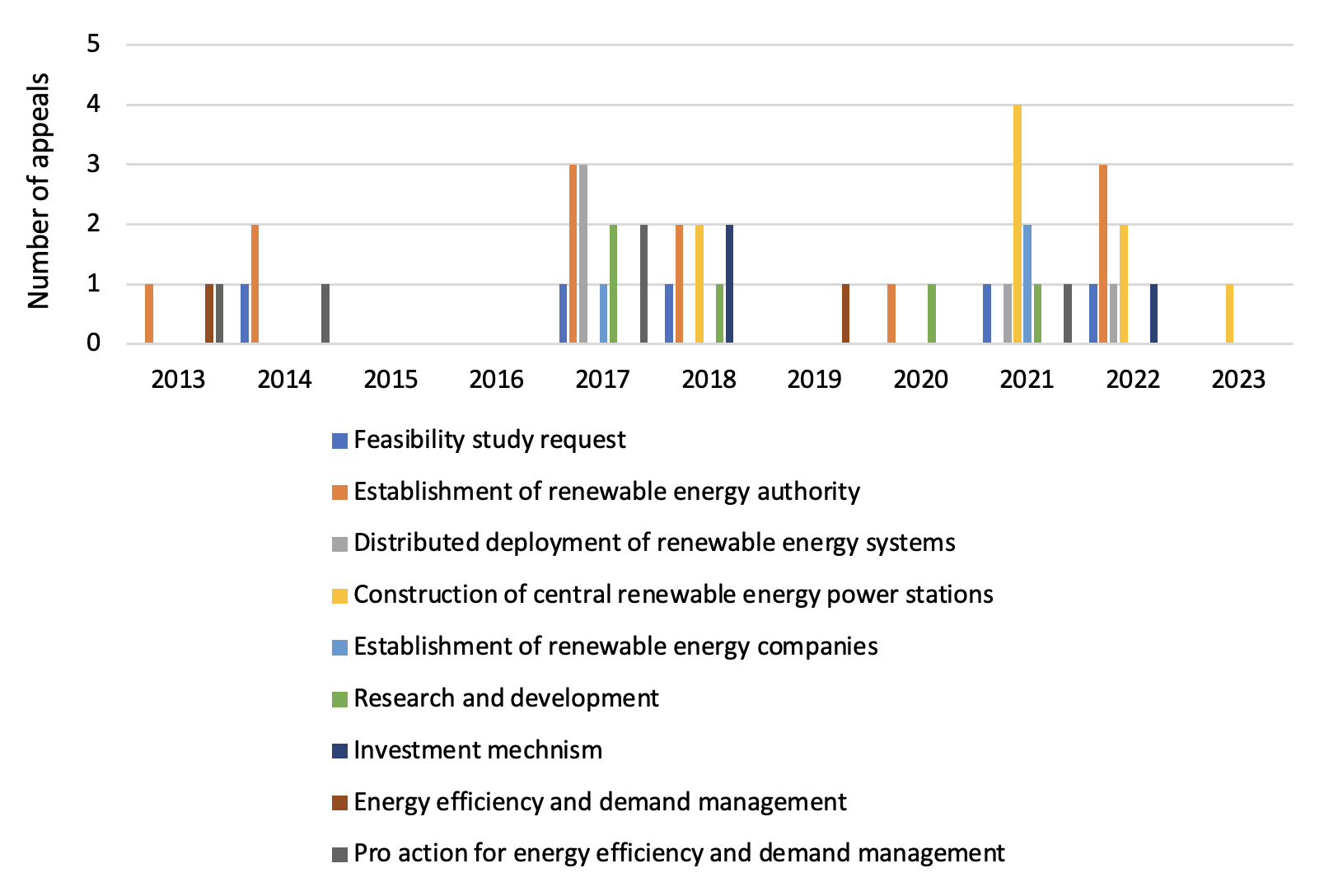
Figure 3 illustrates action by Kuwait’s Cabinet and National Assembly on renewable energy and energy efficiency over time between 2012 and 2023. The variety of energy transition topics and their associated dates imply a lack of coordination between the two houses of government toward renewable energy and energy efficiency goals.
For example, the National Assembly has continued to request renewable energy feasibility studies, even though several studies by public and private research organizations have been conducted and published alongside road maps for the implementation of renewable energy and energy efficiency projects.[19] The country’s legislative authority appears uninformed, and would benefit from greater communication by the Cabinet on the findings of these research studies. Such cooperation would help the Kuwaiti government to better plan for and reach renewable energy milestones.
An appeal for the establishment of a national renewable energy authority further suggests a lack of coordination between the two chambers. The National Assembly has repeatedly called for the establishment of such an authority, submitting its last of 12 total appeals in 2022. The appeals would be a positive step toward renewable energy goals, but given that there is an existing Ministry of Electricity, Water and Renewable Energy (the country’s authority and regulator of electricity generation and distribution), a new energy authority would instead lead to administration and bureaucracy inflation in the sector by lengthening processes and increasing delays. This illustrates a need for the Cabinet to communicate with the National Assembly about its institutions, which oversee renewable energy regulations, to develop and advance related legislation.
Moreover, the data also shows that the National Assembly’s stated interest in supporting research and development (R&D) in the country is contrary to its legislative agenda. The Kuwait Institute for Scientific Research (KISR), the country’s only government research institute, was a pioneer in the development of renewable energy systems in the GCC region during the 1970s and 1980s. KISR revived its renewable energy research in 2008 and has been advocating for an expanded R&D agenda since then.[20] Nonetheless, the National Assembly voted in each of the past five years to cut KISR’s R&D budget — reducing it from US$363 million in 2017 to US$122 million in 2022.[21] Meanwhile, it appealed on four occasions in 2017, 2018, 2020, and 2021 to support R&D expenditures (Figure 3). This implies that R&D lacks popularity and is not a legislative priority. In any case, the R&D expenditure in Kuwait is low; the country’s R&D expenditure percentage of GDP was 0.18% in 2020, compared to 1.45% in the UAE, 0.52% in Saudi Arabia, and a global average of 2.63%.[22]
Given that Kuwait announced in 2012 its goal of meeting 15% of local electricity demand from renewable energy sources by 2030, the assembly’s appeals for the construction of central renewable energy power plants in 2018, 2021, and 2023 came late. This, once more, illustrates the low priority of the energy transition agenda in the political system.
Each of the National Assembly’s suggestions for desired action, suggestions of laws, and bills display a strong positive attitude toward the adoption of clean energies and environmental protection. At the same time, however, there have been active calls to increase subsidies for fossil fuels and their byproducts (gasoline, electricity, etc.), constituting about 30% of all appeals (Figure 4). Kuwait’s high hydrocarbon fuel and electricity subsidies leave no room for renewable or clean energy technologies to compete with conventional energy sources. Moreover, higher subsidies and greater energy debt relief for Kuwaiti citizens would counteract efforts to establish national renewable energy companies, which have been called for by the National Assembly. While there were a few calls for subsidy reforms in 2013 and 2014, these were unpopular (there were two pro-subsidy reform appeals compared to 17 anti-subsidy reform appeals) and are not likely to be pursued in the foreseeable future.
Figure 4 — Proposed Pro- and Anti-energy Transition Actions and Laws, 2013-2023 (National Assembly)
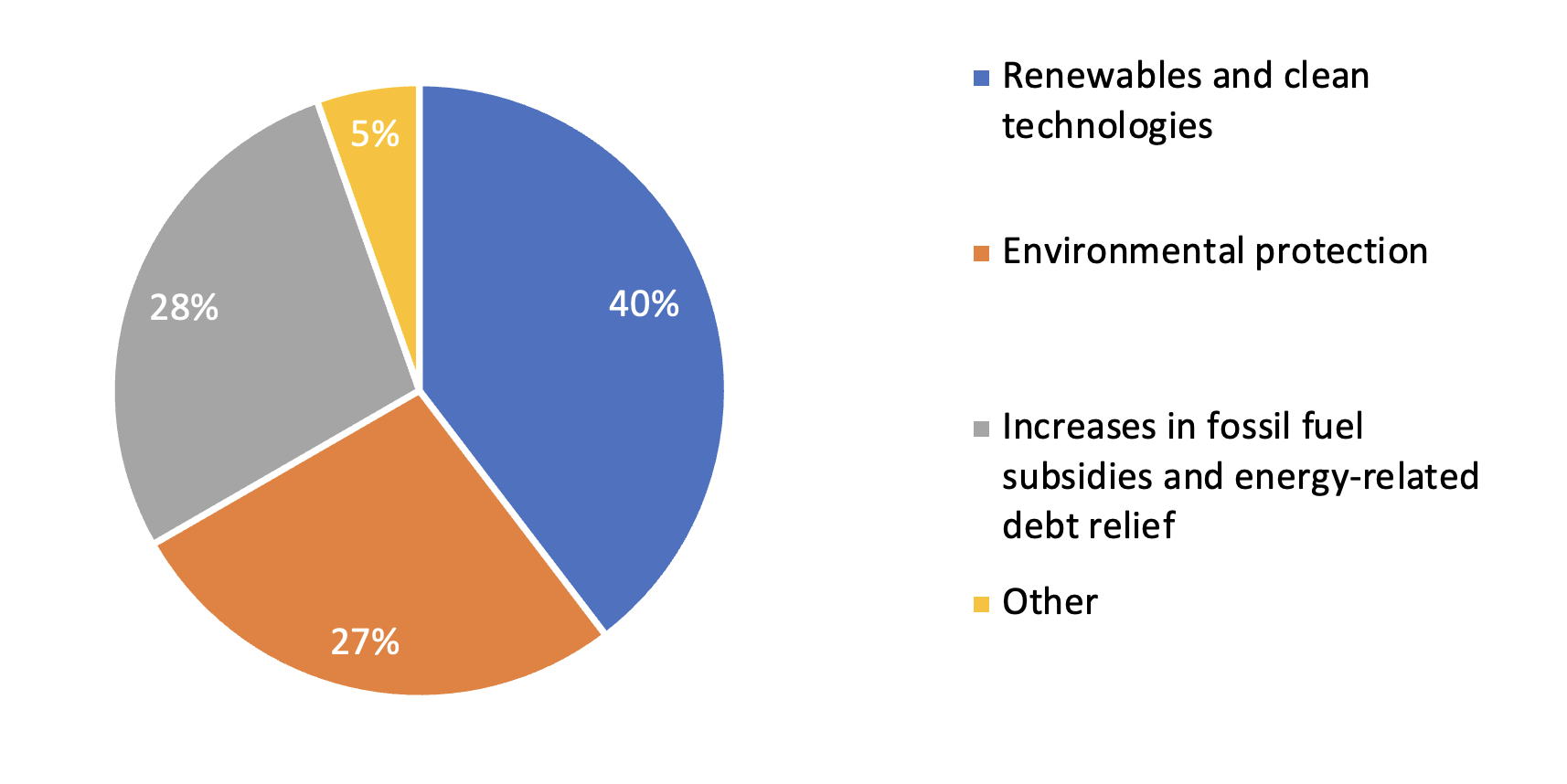
Though most of the energy transition-related appeals advocate for renewable or clean energy technologies (i.e., 40% of energy transition-related appeals), none of the proposals have materialized — reflecting the overall progress of renewable energy deployment in Kuwait. Today, renewables contribute about 0.2% of total electricity generation.[23] There is no official, systematic governance structure for renewable and clean energy supply chain deployment, including investment, incentives, market, infrastructure, etc. This implies that the Cabinet and National Assembly have only dealt superficially with the development of renewable energy projects. So far, the energy transition in Kuwait is an ambitious vision to be realized in the long-term future.
Results and Policy Recommendations
The above analysis illustrates three main factors hindering the Kuwaiti government’s progress toward energy transition goals:
- Lack of Coordination. Table 4 and Figure 3 show that legal and legislative proposals are scattered across energy objectives, rather than focused on well-defined, implementable programs for achieving energy transition goals. The disconnected appeals reflect the lack of coordination among government agencies, the National Assembly, and the Cabinet.
- Contradictory Legal and Legislative Proposals. The adoption of clean energy sources, the application of energy-efficient measures, the mitigation of emissions, and waste management are generally considered the pillars of the energy transition. These key drivers must be addressed together in order for the energy transition to ultimately advance, but the National Assembly has promoted some while impeding others. For example, assembly members have advocated for renewable energies and environmental protection while discouraging energy efficiency (i.e., by promoting energy subsidies and energy debt relief).
- Low Interest in Advancing the Energy Transition. The global energy transition is not only about technology-related systems deployment. Kuwait and the other GCC countries will also need to develop a practice of sustaining local natural resources and protecting the environment while enhancing quality of life — a practice that conflicts with the rentier culture in Kuwait. As such, the political system is less interested in advancing the energy transition agenda than in managing wealth distribution.
Kuwait’s political system compels most of its policymakers, who are freely elected by the public, to protect the country’s rentier culture and, subsequently, undermine its energy transition progress. Its pro-rentier democracy thus has an indirect — but profound — role in slowing the advancement of its energy transition agenda.
On the one hand, the Kuwaiti government aspires to reach the country’s renewable energy target and protect the environment. On the other hand, it works persistently to maintain the societal status quo, which prioritizes consumption. This leads to inefficient demand management, which undermines the fundamental goals of the energy transition — i.e., sustaining natural resources (by diversifying the energy mix) and protecting the environment (by utilizing clean technologies) while enhancing quality of life. The data illustrated in Table 4 and Figure 3 suggests that for the foreseeable future, the Kuwaiti government, in particular the National Assembly, is unlikely to advance any tangible action toward reforming the country’s consumption-driven society. There have been calls to offset high subsidies for fossil fuels and their byproducts with high-cost incentives for the use of clean energy technologies. But this incentive mechanism is unsustainable and impractical. The bottom line is that as long as the Kuwaiti government pursues higher subsidies for fossil fuels and their byproducts and greater energy-related debt relief, it will be hindering the country’s energy transition progress.
In general, democratic political systems represent the average ideals of society and pursue the will of the public. Since Kuwait began exporting oil in the 1940s, its citizenry has become accustomed to a rentier state culture in which wealth distribution management dominates public and political affairs.[24] Its political system is more focused on the consumption and management of natural resources[25] than knowledge work and non-oil industries, and the issue of wealth distribution has also fueled tensions between the Cabinet and the National Assembly.[26] As such, the energy transition agenda is a low priority for the political system.
Unlike in non-democratic GCC states, where the ruling elite make decisions and carry them out accordingly, Kuwait’s political system allows legal and legislative authorities to be selective with the policies they ultimately choose to advance. In other words, Kuwait has taken a piecemeal approach to the energy transition, rather than adopting an integrated strategy including clean energy resources, efficient energy consumption, and protective environmental measures. There is no straightforward way to overcome the challenges this political approach poses for Kuwait’s energy transition goals. But certain policies could help loosen the knot.
In the short term, the Cabinet should coordinate with members of the National Assembly who support pursuing an integrated approach to the energy transition (i.e., involving renewable energy deployment, energy demand management, and environmental protection) to propose and lobby for more energy transition-related legislation. They should advocate for policies that encourage and pave the way for investment reforms, promote efficient energy consumption and more effective adoption of clean technologies, and support R&D in the field. In addition, stakeholders should develop a communications campaign involving conferences, public discussions and debates, and media advertisements that illustrate the importance of holistically pursuing the energy transition.
One can see that the issue at hand for Kuwait is not a technological transition. Instead, its main challenge is encouraging society to embrace clean and efficient energy consumption. The government will need to implement long-term policy changes if it is to embed energy transition values in societal norms. For example, it should alter the education system to promote a culture of creativity, productivity, responsibility, and achievement, instead of promoting consumption and the rentier system. This shift in values is key not only for advancing the energy transition, but for promoting economic prosperity and sustainable quality of life.
Conclusion
This paper examines the role that political systems in GCC states play in advancing (or discouraging) the energy transition agenda. Kuwait — a constitutional monarchy whose parliament is freely elected and the only democratic country in the GCC — has ranked last in tangible measures of progress toward the energy transition among the GCC states. This paper thus aimed to determine whether Kuwait’s democratic system contributes to its slow pace of development toward energy transition goals.
The Kuwait National Assembly’s document database was used to identify and review proposed and enacted laws and legislation involving issues in renewable energy, energy efficiency, and environmental protection from Jan. 1, 2012, to Jan. 31, 2023. This method demonstrated the government’s attitudes and goals related to the energy transition and thus allowed us to deduce the role of the democratic political system in Kuwait.
In this paper, it is assumed that a successful clean energy transition will require an integrated approach involving three main pillars — namely, increasing the proportion of clean energy resources in the energy portfolio, applying energy efficiency measures, and protecting the environment. The analysis shows that the democratic political system in Kuwait plays an indirect role in slowing the advancement of the energy transition; although the Kuwait National Assembly has advocated for deploying renewable energy and protecting the environment, it lacks the desire to adopt the full energy transition package. This would necessarily include energy demand management, which usually involves unpopular measures such as energy subsidy reforms, higher tariffs, new or increased taxes, and consumer investments in efficient materials and technologies.
Because Kuwait’s National Assembly is freely elected by the public, who impel policymakers to refrain from adopting energy efficiency measures, the country’s political system is significantly involved in the floundering of energy transition goals. Addressing these challenges requires the government to implement short-term policies to raise public awareness and long-term policies to alter society’s collective mind by means of education.
This study is potentially limited by the need for additional qualitative analysis, which could be conducted through private discussion forums and in-person interviews with key individuals, e.g., current and former members of government and public affairs experts. This research could provide further information about interactions within Kuwait’s political system (i.e., between the Cabinet and National Assembly) with respect to the country’s energy transition progress, and should be pursued through social science research.
It should be stressed that the political system is not the only factor influencing the development of the energy transition in Kuwait. There are other dynamics that also need to be investigated. Potential examples include environmental factors (e.g., Kuwait’s harsh climate), geographic limitations, and geopolitical concerns about the energy transition agenda.
This study should not be taken as evidence that Kuwait’s democratic system has an unavoidable negative impact on the country’s progress toward its developmental goals. Instead, it should be looked at as an analysis of the lessons learned from the exercise of Kuwait’s political system on the energy transition agenda.
Endnotes
[1] Marina Fischer-Kowalski et al., “Energy transitions and social revolutions,” Technological Forecasting and Social Change 138 (January 2019): 69–77, https://doi.org/10.1016/j.techfore.2018.08.010.
[2] John Wiseman, “The great energy transition of the 21st century: The 2050 Zero-Carbon World Oration,” Energy Research & Social Science 35 (January 2018): 227–232, https://doi.org/10.1016/j.erss.2017.10.011.
[3] Gautam Kumra and Jonathan Woetzel, “What it will cost to get to net-zero,” Business Times, January 29, 2022, https://www.mckinsey.com/mgi/overview/in-the-news/what-it-will-cost-to-get-to-net-zero.
[4] John Meckling et al., “Why nations lead or lag in energy transitions,” Science 378, no. 6615 (October 2022): 31–33, https://www.science.org/doi/10.1126/science.adc9973; Tiago Neves Sequeira and Marcelo Serra Santos, “Renewable energy and politics: A systematic review and new evidence,” Journal of Cleaner Production 192 (August 2018): 553–568, https://doi.org/10.1016/j.jclepro.2018.04.190; Benjamin K. Sovacool et al., “Conflicted transitions: Exploring the actors, tactics, and outcomes of social opposition against energy infrastructure,” Global Environmental Change 73 (March 2022), https://doi.org/10.1016/j.gloenvcha.2022.102473.
[5] Sovacool et al., “Conflicted transitions: Exploring the actors, tactics, and outcomes”; Sikandar Abdul Qadir et al., “Incentives and strategies for financing the renewable energy transition: A review,” Energy Reports 7 (November 2021): 3590–3606, https://doi.org/10.1016/j.egyr.2021.06.041.
[6] Jungwao Lee, Jae-Suk Yang, “Global energy transitions and political systems,” Renewable and Sustainable Energy Reviews 115 (November 2019), https://doi.org/10.1016/j.rser.2019.109370.
[7] Sabine Hielscher, Julia M. Wittmayer, and Alicja Dańkowska, “Social movements in energy transitions: The politics of fossil fuel energy pathways in the United Kingdom, the Netherlands and Poland,” The Extractive Industries and Society, 10 (June 2022), https://doi.org/10.1016/j.exis.2022.101073; David J. Hess, “Cooler coalitions for a warmer planet: A review of political strategies for accelerating energy transitions,” Energy Research & Social Science 57 (November 2019), https://doi.org/10.1016/j.erss.2019.101246; Ji-Bum Chung and Eun-Sung Kim, “Public perception of energy transition in Korea: Nuclear power, climate change, and party preference,” Energy Policy 116 (May 2018): 137–144, https://doi.org/10.1016/j.enpol.2018.02.007.
[8] Karoliina Isoaho and Kamilla Karhunmaa, “A critical review of discursive approaches in energy transitions,” Energy Policy 128 (May 2019): 930–942, https://doi.org/10.1016/j.enpol.2019.01.043; Jonathan Hanto et al., “South Africa's energy transition – Unraveling its political economy,” Energy for Sustainable Development 69 (August 2022): 164–178, https://doi.org/10.1016/j.esd.2022.06.006; Michelle Graff, Sanya Carley, and David M. Konisky, “Stakeholder perceptions of the United States energy transition: Local-level dynamics and community responses to national politics and policy,” Energy Research & Social Science 43 (September 2018): 144–157, https://doi.org/10.1016/j.erss.2018.05.017.
[9] Rachel Freeman, “Modelling the socio-political feasibility of energy transition with system dynamics,” Environmental Innovation and Societal Transitions 40 (September 2021): 486–500, https://doi.org/10.1016/j.eist.2021.10.005; Inese Zepa, “From energy islands to energy highlands? Political barriers to sustainability transitions in the Baltic region,” Energy Research & Social Science 93 (November 2022), https://doi.org/10.1016/j.erss.2022.102809; Lorenz Kammerman and Clau Dermont, “How beliefs of the political elite and citizens on climate change influence support for Swiss energy transition policy,” Energy Research & Social Science 43 (September 2018): 48–60, https://doi.org/10.1016/j.erss.2018.05.010.
[10] David Hopwood, “Abu Dhabi's Masdar plan takes shape,” Renewable Energy Focus 11, no. 1 (January-February 2010): 18–23, https://doi.org/10.1016/S1755-0084(10)70025-9.
[11] Mengye Zhu, Ye Qi and Nathan Hultman, “Low-carbon energy transition from the commanding heights: How state-owned enterprises drive China’s wind power miracle,” Energy Research & Social Science 85 (2022), https://doi.org/10.1016/j.erss.2021.102392.
[12] State of Kuwait Constitution, https://www.kna.kw/Dostor/Dostor/15/37.
[13] Jane Kinninmont, Kuwait’s Parliament: An Experiment in Semi-democracy, Middle East and North Africa Programme, Chatham House, August 2012, https://www.agora-parl.org/sites/default/files/agora-documents/kuwait_parliament_0.pdf; Abdullah Shayji, Kuwait: A Democratic Model in Trouble, Carnegie Endowment for International Peace, February 2009, https://carnegieendowment.org/sada/22700.
[14] Maged Mahmoud and Ali Habib, Arab Future Energy Index 2019 – Renewable Energy (Cairo: Regional Center for Renewable and Energy Efficiency); Rawad Rizk, Hussam Alherafi, and Meredith Brand, Arab Future Energy Index 2017 – Energy Efficiency (Cairo: Regional Center for Renewable and Energy Efficiency).
[15] International Renewable Agency, Renewable Energy Capacity Statistics 2022 (Abu Dhabi: International Renewable Energy Agency); World Bank Open Data, https://data.worldbank.org/.
[16] “Slab Tariff,” Dubai Electricity and Water Authority, Government of Dubai, https://www.dewa.gov.ae/en/consumer/billing/slab-tariff.
[17] Ministerial Decree No. 28/2017 as per Law No. 20, 2016, Ministry of Electricity, Water and Renewable Energy, Kuwait.
[18] Kuwait National Assembly Information System, http://bit.ly/42ooyal.
[19] Osamah Alsayegh et al., Development of a Strategy for the Exploitation of the Renewable Energy in the State of Kuwait, Final Report EA038C, Kuwait Institute for Scientific Research, Kuwait (2012); S. Alhajraf and O. Heil, Feasibility Study of Renewable Energy Technologies for Power Generation in the State of Kuwait, Final Report, KISR 10673, Kuwait Institute for Scientific Research (2011).
[20] Osamah Alsayegh et al., “The Future of Kuwait’s Energy System: Mitigating Threats and Seizing Opportunities – White Paper on a Sustainable National Energy Strategy, Technical Report EU061S,” Kuwait Institute for Scientific Research, Kuwait (2017).
[21] Ministerial Decree No. 28/2017 as per Law No. 20, 2016, Ministry of Electricity, Water and Renewable Energy, Kuwait.
[22] “Research and development expenditure,” World Bank, https://data.worldbank.org/indicator/GB.XPD.RSDV.GD.ZS.
[23] Osamah Alsayegh, “Barriers facing the transition toward sustainable energy system in Kuwait,” Energy Strategy Reviews 38 (November 2021), https://doi.org/10.1016/j.esr.2021.100779.
[24] Yousif M. Mohammad Alameen. “The Norwegian Oil Experience of Economic Diversification: A Comparative Study with Gulf Oil,” European Journal of Business and Management 8, no. 15 (2016): 94–101.
[25] Fiona MacDonald, “Kuwait Parliament Approves State Budget With Narrower Deficit,” Bloomberg, November 1, 2022, https://www.bloomberg.com/news/articles/2022-11-01/kuwait-parliament-approves-state-budget-with-narrower-deficit.
[26] Kristian Coates Ulrichsen, “Kuwait Muddles through Its Confusing Politics,” Arab Center Washington DC, July 20, 2021, https://arabcenterdc.org/resource/kuwait-muddles-through-its-confusing-politics/.
The author would like to recognize the efforts of the Secretariat of the Kuwait National Assembly (KNA) for its professionalism in the development of the KNA databases. Public access to the KNA databases demonstrates transparency, which is one of the main pillars of democracy.
This material may be quoted or reproduced without prior permission, provided appropriate credit is given to the author and Rice University’s Baker Institute for Public Policy. The views expressed herein are those of the individual author(s), and do not necessarily represent the views of Rice University’s Baker Institute for Public Policy.



